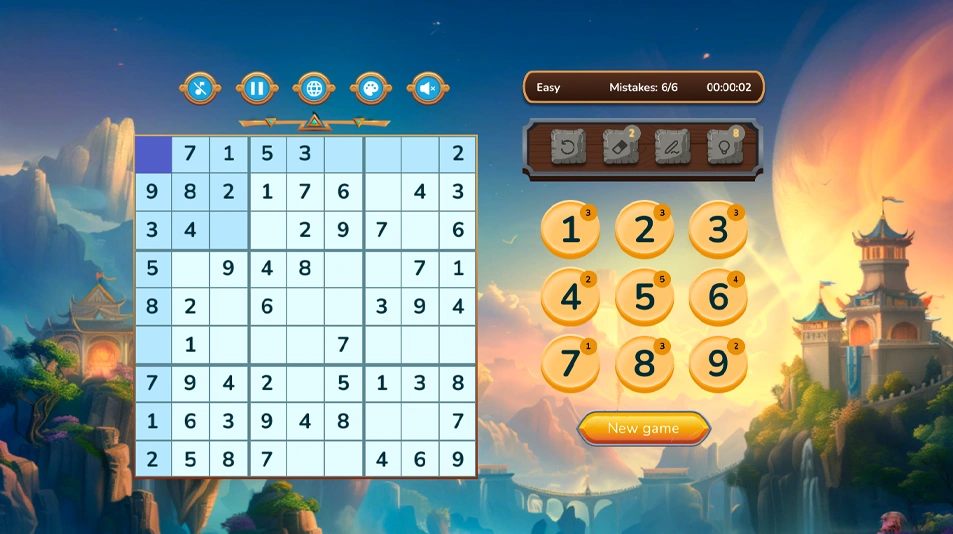Sudoku Secrets: A Guide for All Levels

Sudoku is a global phenomenon that is still played worldwide for a reason. Some find the appeal of this game in logic, while others enjoy the fact that every puzzle presents a new challenge. However, everyone who tried this game would agree that the satisfaction you get from solving Sudoku is worth coming back.
Although no puzzle is the same, the Sudoku rules and its structure stay intact. In this quick guide, you learn everything you should know about Sudoku rules and handy tips to master this amazing game.
Why Sudoku Became So Popular
The Sudoku story starts with 18th-century Swiss mathematician, Leonhard Euler. He came up with the ‘Latin Squares’ concept. These were grids where each number or symbol appeared only in each row and column.
Japanese creator, Maki Kaji, used this concept when creating the Sudoku game puzzle for Nikoli magazine in 1984. Its logical structure, pattern recognition, and problem-solving elements had broad appeal. Newspapers, puzzle books, and later, mobile apps helped make Sudoku a worldwide favorite.
While math and strategy games have waxed and waned, Sudoku endures. Its simple format offers endless challenges, with every puzzle feeling like a fresh test of logic. Completing a challenging puzzle provides a potent hit of accomplishment.
With digital versions now available, Sudoku's accessibility continues to grow. Easy to learn yet endlessly rewarding, it remains one of the most popular puzzles worldwide.
Sudoku Rules for Beginners

Sudoku requires understanding a few basic rules. With the right approach, beginners can grasp the game quickly.
1. Understanding the Grid
The Sudoku gird contains nine columns, nine rows, and nine 3x3 squares that you should fill with 1 through 9 numbers. To complete the puzzle, numbers in every column, square, and row cannot repeat themselves.
2. How to Place Numbers
To start placing numbers, identify any boxes already containing numbers. Then, examine each empty box and ask: Which numbers are missing from this row, column, and subgrid? Through the elimination process, you can deduce which numbers remain valid options. If only one number fits within all three constraints, place it confidently.
3. The Key to Logical Deduction
Continue scanning rows, columns, and subgrids to make logical deductions. Work through empty boxes one at a time, cross-referencing the possibilities. With practice, you will eliminate unlikely numbers faster. Instead of guessing, focus on pattern recognition and logical steps.
Tips and Tricks for Solving Sudoku

For beginners, focus on filling in the most obvious numbers first. Look for rows, columns, or 3×3 subgrids that are nearly complete. The process of elimination will help fill in the remaining boxes. Once you've placed all the easy numbers, move on to more complex strategies.
Intermediate players use techniques like "penciling in" possible candidates for each blank square. Lightly writing down potential numbers allows you to track options without committing too soon. As you refine your notes, you'll start spotting patterns that help narrow choices.
Advanced solvers use logical techniques like "Naked Pairs" and "X-Wing," which help eliminate impossible numbers across multiple squares. While these strategies may seem confusing at first, regular practice makes them easier to apply. Master solvers use such techniques to tackle even the toughest puzzles.
The Evolution of Sudoku in Modern Gaming
The rules of Sudoku may initially seem tricky. However, by applying careful logic while working through the grid, players can steadily improve and solve puzzles faster. Mastering the techniques of elimination and cross-referencing leads to satisfaction as the solution emerges.
Today, Sudoku is available on mobile apps, websites, and even gaming consoles. Digital Sudoku often includes features like adjustable difficulty levels, hints, and time-based challenges, making it even more engaging. With a few taps on a screen, players can enjoy Sudoku anytime, anywhere.


